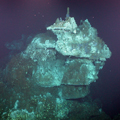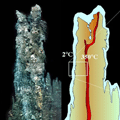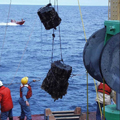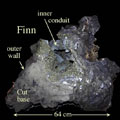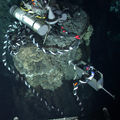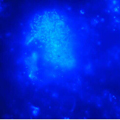investigations
background
Understanding the in-situ conditions under which microorganisms survive, thrive and expire in one of the most extreme environments on Earth
One of the most profound discoveries in the past 20 years has been the recognition of dense and diverse biological communities thriving in the absence of sunlight that are supported by gases released from submarine volcanoes thousands of feet beneath the surface of the ocean (Diffusely Venting Chimney in Main Endeavour Field). This discovery and follow-on research has significantly changed the way we think about life on our planet and it has redefined what we consider habitable zones.
This research has lead to a growing recognition that the subsurface biomass within the oceanic crust may rival that of the earth’s entire surface. Recent discoveries about the subsurface biosphere in submarine environments have lead to new insights into the origin of life and into how life may have evolved on our plane. They have also provided new explanations for the formation of some energy deposits along active margins. These studies are leading to new areas of biotechnical research that view subsurface organisms as resources for development of new pharmaceuticals important in fighting disease and infections and biocatalysts (enzymes) that are more efficient, more thermally stable and more cost-effective than synthetic catalysts important in material processing for industries
Some of the most novel microorganisms live in one of the most extreme environments on our planet—acidic underwater hot springs with fluids rich in metals, carbon dioxide, and hydrogen sulfide that reach temperatures of 407°C (765°C). The outer surfaces of these black smoker chimneys are bathed in a mixture of 2°C, oxygenated seawater and warm vent fluid escaping from within the structures (Extreme Environments in Black Smokers). The inner walls bounding the central up-flow conduits commonly exceed 300°C, with temperatures fixed by a steady supply of rapidly rising, strongly reducing vent fluid. Between these two extremes is a region that bounds the upper temperature limit to life.
Early Investigation of the Limits To Life: The Edifice Rex Sulfide Recovery Project
Within the walls of active smokers, where steep gradients in thermal and chemical conditions exist, the limits to life are beginning to be defined. The chimneys are natural laboratories for studying microbial metabolic processes thought to be ancient on Earth. That is what makes this study and those of similar sulfide chimneys particularly exciting and important to underwater researchers. Until twenty years ago, no one thought life would be possible under the extreme conditions present in the deep ocean where sunlight does not penetrate and pressures are hundreds of times higher than those on land.
In 1998 four large sulfide structures (up to 2 m in length and weighing up to 4,000 lbs) (Recovery of the Sulfide Chimney Called Roane) from the Mothra Hydrothermal Field on the Endeavour Segment of the Juan de Fuca Ridge were recovered to begin investigation into the extreme limits to life, (Delaney et al., 2001) (http://www.pbs.org/wgbh/nova/abyss/mission/). The belief was that the sulfide structures provide a window into processes similar to those that operate deep within the seafloor, but which are not easily accessible with our current technologies. Many actively forming sulfide deposits rise tens of meters above the seafloor and represent conveniently accessible extensions of the subsurface microbial habitat. As such, they can be more readily sampled than larger blocks of material from below the seafloor.
Analyses of these chimneys showed that microorganisms abound throughout the sulfide structures. Hyperthermophilic archaea (ancient microbes that thrive at temperatures in excess of 80°C) were cultured from within the walls of all four of the chimneys recovered and all contained very high concentrations of microorganisms. A transect from the hot 300°C interior to the cool outer walls (~10°C) of a vigorously venting chimney called Finn showed corresponding changes in mineral zones and microbial community (Base of 300°C Black Smoker Chimney) with evidence for microbial products even within the hottest interior. Based on this initial study, Kelley and Delaney embarked on a program to build a sensor that would allow examination of both the in-situ environmental conditions and organisms within the walls of black smoker chimneys as an expansion of the Edifice Rex program and complementary to the Keck effort.
Looking at Life in the Extreme; Development of an In-Situ Microbial Incubator
To begin to quantify the upper temperature limit to life, the kinds of microbes (Microbes Recovered From Black Smoker) that inhabit the walls of active black smoker chimneys and the extreme environmental conditions under which they live, a new in-situ sensor was developed called a sulfide microbial incubator (Sulfide Microbial Incubator in Roane). The National Science Foundation, through the RIDGE2000 program, provided funding for this experimental and field effort.
This prototype instrument is a titanium-sheathed, 53 cm long, 4-chambered probe that allows in-situ, continuous recording of 36 temperatures within the interior walls of mature, active hydrothermal chimneys. One chamber includes a sensor for continuous measurement of dissolved hydrogen (H2), and two osmo samplers for coregistered time-series sampling of hydrothermal fluids in two of the chambers. A data logging package is enclosed in a second titanium pressure housing (commonly referred to as a ‘pig’) that allows continuous measurements of temperature and H2 to be stored for the duration of the experiment. Sterile mineral phases and synthetic materials are placed inside each chamber for colonization surfaces for microorganisms.
During the first part of this cruise, three of these new instruments will be deployed into the walls of active chimneys in the Mothra and Main Endeavour Hydrothermal Fields. We will use the robotic vehicle Jason 2 to drill into the black smoker edifices, and insert the incubators. Once in place, the incubation chambers will then be opened, allowing hydrothermal fluids to migrate vertically through the individual chambers. Near the end of this 5 week expedition, at least two of the incubators will be recovered, environmental data downloaded and the newly colonized microbes will be processed for shore-based studies of their DNA, metabolic activity, and diversity with respect to temperature, and fluid and volatile chemistry. After the data and microbes have been recovered, the incubators will be redeployed into the same experimental holes for a long-term, 1-year deployment.
The upper temperature limit to life is a key environmental parameter in determining the depth to which microorganisms can live beneath the seafloor, how the biosphere functions, and how it varies in space and time. Determining the maximum conditions under which life can live is also critical to the understanding of how and where life might have evolved on our planet and for investigation of life in extraterrestrial environments. Integration of results from this pioneering experiment will allow definition of key environmental parameters that are important to understanding processes operative within sulfide-microbial habitats and the mechanisms by which submarine volcanoes and their associated hydrothermal systems support life.
